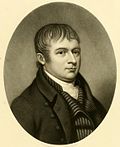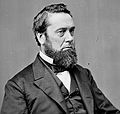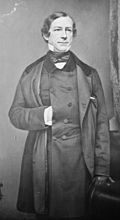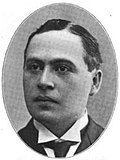Member Party Years Cong Electoral history District location District established March 4, 1793 James Gordon (Schenectady ) Pro-Administration March 4, 1793 – 3rd Redistricted from the 6th district and re-elected in 1793 . John Williams (Salem ) Democratic-Republican [ 8] March 4, 1795 – 4th 5th Elected in 1794 .Re-elected in 1796 . 7th district and lost re-election. Federalist [ 9] [ 10] March 4, 1797 – Jonas Platt (Poughkeepsie ) Federalist March 4, 1799 – 6th Elected in 1798 . Benjamin Walker (Utica ) Federalist March 4, 1801 – 7th Elected in 1800 . Killian K. Van Rensselaer (Albany ) Federalist March 4, 1803 – 8th 9th 10th Redistricted from the 8th district and re-elected in 1802 .Re-elected in 1804 .Re-elected in 1806 . 7th district . Thomas Sammons (Johnstown ) Federalist [ 11] March 4, 1809 – 11th 12th Elected in 1808 .Re-elected in 1810 . Democratic-Republican [ 12] March 4, 1811 – John Lovett (Albany ) Federalist March 4, 1813 – 13th 14th Elected in 1812 .Re-elected in 1814 . Rensselaer Westerlo (Albany ) Federalist March 4, 1817 – 15th Elected in 1816 . Solomon Van Rensselaer (Albany ) Federalist March 4, 1819 – 16th 17th Elected in 1818 .Re-elected in 1821 .postmaster of Albany . Vacant January 14, 1822 – 17th Stephen Van Rensselaer (Albany ) Federalist March 12, 1822 – Elected to finish his cousin's term . 10th district . James L. Hogeboom (Castleton ) Crawford March 4, 1823 – 18th Elected in 1822 . William McManus (Troy ) Anti-Jacksonian March 4, 1825 – 19th Elected in 1824 . John D. Dickinson (Troy ) Anti-Jacksonian March 4, 1827 – 20th 21st Elected in 1826 .Re-elected in 1828 . Job Pierson (Schaghticoke ) Jacksonian March 4, 1831 – 22nd 23rd Elected in 1830 .Re-elected in 1832 . Hiram P. Hunt (Troy ) Anti-Jacksonian March 4, 1835 – 24th Elected in 1834 . Henry Vail (Troy ) Democratic March 4, 1837 – 25th Elected in 1836 . Hiram P. Hunt (Troy ) Whig March 4, 1839 – 26th 27th Elected in 1838 .Re-elected in 1840 . James G. Clinton (Newburgh ) Democratic March 4, 1843 – 28th Redistricted from the 6th district and re-elected in 1842 . Archibald C. Niven (Monticello ) Democratic March 4, 1845 – 29th Elected in 1844 . Daniel B. St. John (Monticello ) Whig March 4, 1847 – 30th Elected in 1846 . Thomas McKissock (Newburgh ) Whig March 4, 1849 – 31st Elected in 1848 . William Murray (Goshen ) Democratic March 4, 1851 – 32nd Elected in 1850 . 10th district . Jared V. Peck (Port Chester ) Democratic March 4, 1853 – 33rd Elected in 1852 . Bayard Clarke (New York ) Opposition March 4, 1855 – 34th Elected in 1854 . John B. Haskin (Fordham ) Democratic March 4, 1857 – 35th 36th Elected in 1856 .Re-elected in 1858 . Anti-Lecompton March 4, 1859 – Edward Haight (Westchester ) Democratic March 4, 1861 – 37th Elected in 1860 . Anson Herrick (New York ) Democratic March 4, 1863 – 38th Elected in 1862 . William A. Darling (New York ) Republican March 4, 1865 – 39th Elected in 1864 . Fernando Wood (New York ) Democratic March 4, 1867 – 40th 41st 42nd Elected in 1866 .Re-elected in 1868 .Re-elected in 1870 . 10th district . David B. Mellish (New York ) Republican March 4, 1873 – 43rd Elected in 1872 . Vacant May 23, 1874 – Richard Schell (New York ) Democratic December 7, 1874 – Elected to finish Mellish's term . Fernando Wood (New York ) Democratic March 4, 1875 – 44th 45th 46th Redistricted from the 10th district and re-elected in 1874 .Re-elected in 1876 .Re-elected in 1878 .Re-elected in 1880 . Vacant February 14, 1881 – 46th 47th John Hardy (New York ) Democratic December 5, 1881 – 47th 48th Elected to finish Wood's term .Re-elected in 1882 . Joseph Pulitzer (New York ) Democratic March 4, 1885 – 49th Elected in 1884 . Vacant April 10, 1886 – Samuel S. Cox (New York ) Democratic November 2, 1886 – 49th 50th 51st Elected to finish Pulitzer's term .Re-elected in 1886 .Re-elected in 1888 . Vacant September 10, 1889 – 51st Amos J. Cummings (New York ) Democratic November 5, 1889 – 51st 52nd Elected to finish Cox's term .Re-elected in 1890 . 11th district . Timothy J. Campbell (New York ) Democratic March 4, 1893 – 53rd Redistricted from the 8th district and re-elected in 1892 .[ data missing ] Henry C. Miner (New York ) Democratic March 4, 1895 – 54th Elected in 1894 . Thomas J. Bradley (New York ) Democratic March 4, 1897 – 55th 56th Elected in 1896 .Re-elected in 1898 . Henry M. Goldfogle (New York ) Democratic March 4, 1901 – 57th 58th 59th 60th 61st 62nd Elected in 1900 .Re-elected in 1902 .Re-elected in 1904 .Re-elected in 1906 .Re-elected in 1908 .Re-elected in 1910 . 12th district . James H. O'Brien (Brooklyn ) Democratic March 4, 1913 – 63rd Elected in 1912 . Oscar W. Swift (Brooklyn ) Republican March 4, 1915 – 64th 65th Elected in 1914 .Re-elected in 1916 . David J. O'Connell (Brooklyn ) Democratic March 4, 1919 – 66th Elected in 1918 . Andrew Petersen (Brooklyn ) Republican March 4, 1921 – 67th Elected in 1920 . David J. O'Connell (Brooklyn ) Democratic March 4, 1923 – 68th 69th 70th 71st Elected in 1922 .Re-elected in 1924 .Re-elected in 1926 .Re-elected in 1928 .Re-elected in 1930 . Vacant December 29, 1930 – 71st Stephen A. Rudd (Brooklyn ) Democratic February 17, 1931 – 71st 72nd 73rd 74th Elected to finish O'Connell's term .Re-elected in 1932 .Re-elected in 1934 . Vacant March 31, 1936 – 74th Eugene J. Keogh (Brooklyn ) Democratic January 3, 1937 – 75th 76th 77th 78th 79th 80th 81st 82nd 83rd 84th 85th 86th 87th Elected in 1936 .Re-elected in 1938 .Re-elected in 1940 .Re-elected in 1942 .Re-elected in 1944 .Re-elected in 1946 .Re-elected in 1948 .Re-elected in 1950 .Re-elected in 1952 .Re-elected in 1954 .Re-elected in 1956 .Re-elected in 1958 .Re-elected in 1960 . 11th district . James J. Delaney (Queens ) Democratic January 3, 1963 – 88th 89th 90th 91st 92nd 93rd 94th 95th Redistricted from the 7th district and re-elected in 1962 .Re-elected in 1964 .Re-elected in 1966 .Re-elected in 1968 .Re-elected in 1970 .Re-elected in 1972 .Re-elected in 1974 .Re-elected in 1976 . Vacant January 1, 1979 – 95th Geraldine Ferraro (Queens ) Democratic January 3, 1979 – 96th 97th 98th Elected in 1978 .Re-elected in 1980 .Re-elected in 1982 .run for U.S. Vice President . Thomas J. Manton (Queens ) Democratic January 3, 1985 – 99th 100th 101st 102nd Elected in 1984 .Re-elected in 1986 .Re-elected in 1988 .Re-elected in 1990 . 7th district . Chuck Schumer (Brooklyn ) Democratic January 3, 1993 – 103rd 104th 105th Redistricted from the 10th district and re-elected in 1992 .Re-elected in 1994 .Re-elected in 1996 .run for U.S. senator . 1993–2003 Brooklyn , Queens Anthony Weiner (Brooklyn ) Democratic January 3, 1999 – 106th 107th 108th 109th 110th 111th 112th Elected in 1998 .Re-elected in 2000 .Re-elected in 2002 .Re-elected in 2004 .Re-elected in 2006 .Re-elected in 2008 .Re-elected in 2010 . [ 13] 2003–2013 Brooklyn , Queens Vacant June 21, 2011 – 112th Robert Turner (Queens ) Republican September 15, 2011 – Elected to finish Weiner's term . 5th district but retired to run for U.S. senator . Yvette Clarke (Brooklyn ) Democratic January 3, 2013 – 113th 114th 115th 116th 117th 118th 119th Redistricted from the 11th district and re-elected in 2012 .Re-elected in 2014 .Re-elected in 2016 .Re-elected in 2018 .Re-elected in 2020 .Re-elected in 2022 .Re-elected in 2024 . 2013–2023 Brooklyn 2023–2025 Brooklyn 2025–present Brooklyn 











































